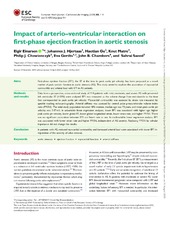| dc.contributor.author | Einarsen, Eigir | en_US |
| dc.contributor.author | Hjertaas, Johannes Just | en_US |
| dc.contributor.author | Gu, Haotian | en_US |
| dc.contributor.author | Matre, Knut | en_US |
| dc.contributor.author | Chowienczyk, Philip J. | en_US |
| dc.contributor.author | Gerdts, Eva | en_US |
| dc.contributor.author | Chambers, John B. | en_US |
| dc.contributor.author | Saeed, Sahrai | en_US |
| dc.date.accessioned | 2020-08-14T09:15:10Z | |
| dc.date.available | 2020-08-14T09:15:10Z | |
| dc.date.issued | 2020 | |
| dc.identifier.issn | 2047-2404 | |
| dc.identifier.uri | https://hdl.handle.net/1956/23760 | |
| dc.description.abstract | Aims: First-phase ejection fraction (EF1), the EF at the time to peak aortic jet velocity, has been proposed as a novel marker of peak systolic function in aortic stenosis (AS). This study aimed to explore the association of myocardial contractility and arterial load with EF1 in AS patients. Methods and results: Data from a prospective, cross-sectional study of 114 patients with mild, moderate, and severe AS with preserved left ventricular EF (>50%) were analysed. EF1 was measured as the volume change from end-diastole to the time that corresponded to peak aortic jet velocity. Myocardial contractility was assessed by strain rate measured by speckle tracking echocardiography. Arterial stiffness was assessed by central pulse pressure/stroke volume index ratio (PP/SVi). The total study population included 48% women, median age was 73 years, and mean peak aortic jet velocity was 3.47 m/s. In univariable linear regression analyses, lower EF1 was associated with higher age, higher peak aortic jet velocity, lower global EF, lower global longitudinal strain, lower strain rate, and higher PP/SVi. There was no significant association between EF1 and heart rate or sex. In multivariable linear regression analysis, EF1 was associated with lower strain rate and higher PP/SVi, independent of AS severity. Replacing PP/SVi by valvular impedance did not change the results. Conclusion: In patients with AS, reduced myocardial contractility and increased arterial load were associated with lower EF1 independent of the severity of valve stenosis. | en_US |
| dc.language.iso | eng | eng |
| dc.publisher | Oxford University Press | eng |
| dc.rights | Attribution-Non Commercial CC BY-NC | eng |
| dc.rights.uri | http://creativecommons.org/licenses/by-nc/4.0/ | eng |
| dc.title | Impact of arterio–ventricular interaction on first-phase ejection fraction in aortic stenosis | en_US |
| dc.type | Peer reviewed | |
| dc.type | Journal article | |
| dc.description.version | publishedVersion | en_US |
| dc.rights.holder | Copyright 2020 The Authors | |
| dc.identifier.doi | https://doi.org/10.1093/ehjci/jeaa154 | |
| dc.identifier.cristin | 1823262 | |
| dc.source.journal | European Heart Journal-Cardiovascular Imaging | |
| dc.source.pagenumber | 650–657 | |
| dc.identifier.citation | European Heart Journal-Cardiovascular Imaging. 2021, 22 (6), 650–657. | |
| dc.source.volume | 22 | |
| dc.source.issue | 6 | |

